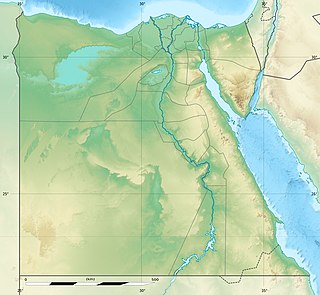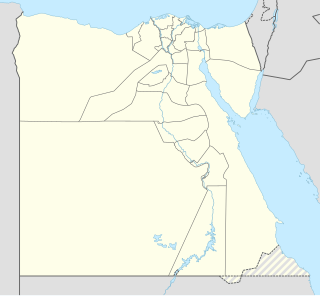Related Research Articles

The Giza Pyramid Complex, also called the Giza Necropolis, is the site on the Giza Plateau in Greater Cairo, Egypt that includes the Great Pyramid of Giza, the Pyramid of Khafre, and the Pyramid of Menkaure, along with their associated pyramid complexes and the Great Sphinx of Giza. All were built during the Fourth Dynasty of the Old Kingdom of Ancient Egypt. The site also includes several cemeteries and the remains of a workers village.

Abusir is the name given to an Egyptian archaeological locality – specifically, an extensive necropolis of the Old Kingdom period, together with later additions – in the vicinity of the modern capital Cairo. The name is also that of a neighbouring village in the Nile Valley, whence the site takes its name. Abusir is located several kilometres north of Saqqara and, like it, served as one of the main elite cemeteries for the ancient Egyptian capital city of Memphis. Several other villages in northern and southern Egypt are named Abusir or Busiri. Abusir is one relatively small segment of the extensive "pyramid field" that extends from north of Giza to below Saqqara. The locality of Abusir took its turn as the focus of the prestigious western burial rites operating out of the then-capital of Memphis during the Old Kingdom 5th Dynasty. As an elite cemetery, neighbouring Giza had by then "filled up" with the massive pyramids and other monuments of the 4th Dynasty, leading the 5th Dynasty pharaohs to seek sites elsewhere for their own funerary monuments.

Prince Ankhhaf was an Egyptian prince and served as vizier and overseer of works to the Pharaoh Khufu, who was Ankhhaf's half-brother. He lived during Egypt's 4th Dynasty.

Queen Meresankh III was the daughter of Hetepheres II and Prince Kawab and a granddaughter of the Egyptian pharaoh Khufu. She was the wife of King Khafre.
Minkhaf I was an ancient Egyptian prince of the 4th Dynasty. He was a son of Pharaoh Khufu, half-brother of Pharaoh Djedefre and elder brother of Pharaoh Khafra. His mother may have been Queen Henutsen. Minkhaf had a wife and at least one son, but their names are not known.

Kawab is the name of an ancient Egyptian prince of the 4th Dynasty. He was the eldest son of King Khufu and Queen Meritites I. Kawab served as vizier and was buried in the double mastaba G 7110–7120 in the east field which is part of the Giza Necropolis.
Khufukhaf I was an ancient Egyptian prince and vizier of the 4th Dynasty.
Kaemsekhem was an ancient Egyptian nobleman and probably the son of Crown Prince Kawab and Hetepheres II. He later served as the director of the royal palace. He was buried in mastaba G 7660 in the Giza East Field, which is part of the Giza Necropolis.

Senedjemib Mehi was a vizier from the Fifth Dynasty of Egypt. Senedjemib Mehi started out his career under Djedkare Isesi and eventually became vizier under Unas.

Meritites II or Meritites A was a 4th Dynasty Princess of Ancient Egypt, and probably a daughter of King Khufu. She may have been a daughter of Meritites I based on the fact that this queen is mentioned in mastaba G 7650. She married the Director of the Palace Akhethotep and she had several children with her husband. Meritites and her husband shared a mastaba G 7650 in Giza.
Rekhetre was an ancient Egyptian queen from the late 4th Dynasty or early 5th Dynasty. She was a daughter of Pharaoh Khafra. Her husband is never mentioned, but Rekhetre would have been the wife of one of Khafre's successors, possibly Menkaure.
Persenet was an ancient Egyptian queen consort of the 4th Dynasty. She may have been a daughter of King Khufu and a wife of King Khafra. She is mainly known from her tomb at Giza.
Nefertkau II was an Ancient Egyptian noble lady, the wife of Prince Khufukhaf I, son of pharaoh Khufu.
Nefertkau III was an ancient Egyptian princess. She lived during the 4th Dynasty. She was possibly a daughter of Meresankh II and Horbaef. If so, she was a granddaughter of King Khufu. Baud has proposed that Nefertkau was a daughter of Khufu instead. Nefertkau has the titles King's daughter of his body and Priestess of Neith in a scene in the chapel of her tomb. She was married to an official named Iynefer. Nefertkau and Iynefer had a daughter also called Nefertkau and two or three sons. Strudwick has suggested that Iynefer may be a son of Khufu. Depending on the interpretation of the family relationships Nefertkau may have married either her uncle or her brother.

The West Field is located on the Giza Plateau, to the west of the Great Pyramid of Giza. It is divided up into smaller areas like the cemeteries known as the Abu Bakr Excavations, as well as several cemeteries whose toponyms are based on the mastaba numbers such as Cemetery G 1000 and Cemetery G 1100. The West Field contains Cemetery G1000 – Cemetery G1600, and Cemetery G 1900. Further cemeteries in this field are: Cemeteries G 2000, G 2200, G 2500, G 3000, G 4000, and G 6000. Three other cemeteries are named after their excavators: Junker Cemetery West, Junker Cemetery East and Steindorff Cemetery.

The East Field is located to the east of the Great Pyramid of Giza and contains cemetery G 7000. This cemetery was a burial place for some of the family members of Khufu. The cemetery also includes mastabas from tenants and priests of the pyramids dated to the 5th and 6th Dynasty.

Cemetery GIS is a necropolis in the Giza Plateau. It derives its name from its proximity to pyramid G I (Khufu). The tombs are located on the south side of that pyramid and hence the name G I South Cemetery. Reisner thought the cemetery a continuation of the G7000 cemetery which is part of the Giza East Field. The construction postdates that of mastaba G 7070 of Sneferukhaf. Junker dated the cemetery to the reign of Menkaure based on the presence of granite powder thought to derive from the dressing of the second pyramid at Giza. Reisner allows for a possible construction date dating to the reign of Khafre.
The Egyptian dog Abuwtiyuw, also transcribed as Abutiu, was one of the earliest documented domestic animals whose name is known. He is believed to have been a royal guard dog who lived in the Sixth Dynasty (2345–2181 BC), and received an elaborate ceremonial burial in the Giza Necropolis at the behest of a pharaoh whose name is unknown.

The Mastaba of Kaninisut, or Mastaba G 2155, is an ancient Egyptian mastaba tomb, located at Giza in the West field of the Great Pyramid of Giza. The cult chamber of the mastaba is now on display in the Kunsthistorisches Museum in Vienna with inventory number 8006. Kaninisut was a high state official in the Fourth dynasty or early Fifth dynasty in the Old Kingdom, as demonstrated by the location and size of his tomb and his numerous honorific titles. The cult chamber of Kaninisut was built of the best quality white Tura limestone and decorated with fine, raised reliefs, which mainly depict offerings, scenes of funerary ritual and Kaninisut with his family. Kaninisut's descendants built additional smaller tombs within the large mastaba.
Qar was an official of the Sixth Dynasty of Egypt. Son of Idu, he probably lived and served between Merenre I and Pepy II.
References
- 1 2 Porter, Bertha; Moss, Rosalind (1974). Topographical Bibliography of Ancient Egyptian Hieroglyphic Texts, Statues, Reliefs and Paintings Volume III: Memphis, Part I Abu Rawash to Abusir (PDF) (2nd (revised and augmented by Dr Jaromir Malek) ed.). Oxford: Clarendon Press. pp. 185–186 – via Digital Giza, Harvard Faculty of Arts and Sciences.
- ↑ Reisner, George A.; Smith, William Stevenson (1942). "Appendix P: Cemetery 7000". A History of the Giza Necropolis III. Harvard University Press.
- 1 2 Strudwick, Nigel (1985). The Administration of Egypt in the Old Kingdom (PDF). Routledge. ISBN 0-7103-0107-3 – via Digital Giza, Harvard Faculty of Arts and Sciences.
- 1 2 3 Simpson, William Kelly (1976). Giza Mastaba Vol 2: The Mastabas of Qar and Idu (PDF). Boston: Museum of Fine Arts, Boston. ISBN 0-87846-093-4 – via Gizapyramids.org.
- 1 2 Jones, Dilwyn (2000). An Index Of Ancient Egyptian Titles Epithets And Phrases Of The Old Kingdom 1 & 2. BAR International Series. 866. British Archaeological Reports. ISBN 978-1841710693.